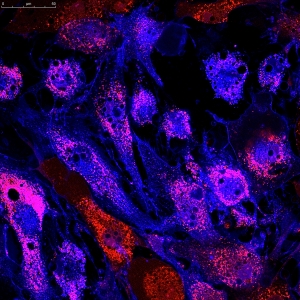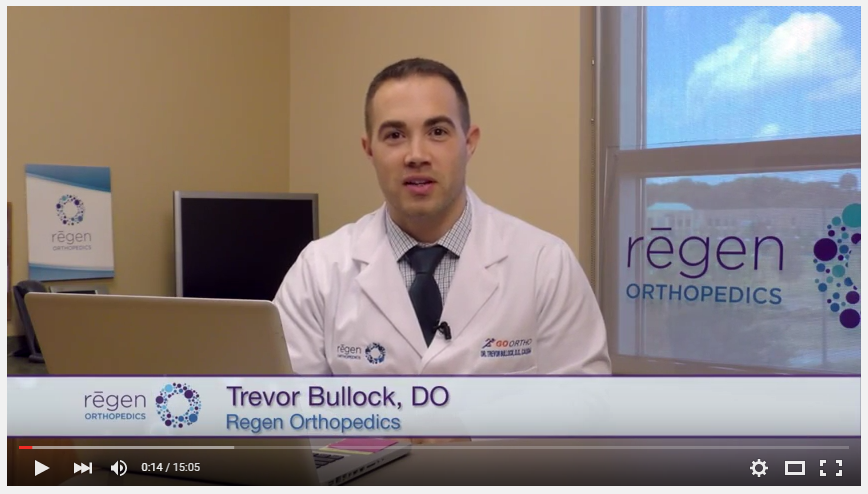What is regenerative medicine?
Regenerative medicine in orthopedics is a non-surgical treatment that can activate your own adult stem cells to repair injured tissues, reduce inflammation and stop pain. Following FDA guidelines, the procedures at Regen Orthopedics utilize your body’s own growth factors, including adult stem cells or blood platelets, to potentially stimulate healing and speed repair for bone, muscle, joint, soft tissue and nerve injuries. It takes the healthy, regenerative cells from an area in which they are more concentrated, and injects them into the injured area of the body. The therapy enables your body to better heal itself. Watch more here.
These therapies can be used for acute injuries but may be especially helpful in treating patients with chronic pain that has not responded to traditional treatments such as anti-inflammatory medications, cortisone injection, physical therapy or surgery. Regenerative medicine can help a number of common conditions: arthritis, tendinitis/tendinosis, painful conditions of the spine, back and neck, knee pain, shoulder pain and joint pain of all types, sports injuries, meniscus tears, ligament sprains, plantar fasciitis, compression nerve injuries. See a full list of conditions. Watch more here.
Regenerative medicine treatments can activate your body’s own adult stem cells and blood platelets to stimulate healing and speed repair for bone, muscle, joint, soft tissue and nerve injuries.
We all have healing stem cells in our bodies. Primarily found in bone marrow and fatty tissue, these cells act as repairmen and stimulate the healing process in the cells around them. There are several different kinds of stem cells. Mesenchymal stem cells (MSC) are the type that we use in orthopedic treatments.
MSCs have the strongest potential to repair muscle, bone, joint and soft tissue injuries. These cells have the ability to self-replicate, reduce inflammation and differentiate into cartilage, bone, muscle and fat cells and may help the body regenerate the lost tissue in the injured area.
They activate your body’s ability to heal itself.
Our regenerative therapies include Platelet Rich Plasma (PRP) and Bone Marrow Concentrate (BMC) therapies. These are being used to effectively alleviate a number of chronic orthopedic conditions, including arthritis, sports injuries, tendinitis/tendinosis, nerve injuries and more. Regenerative medicine can be particularly useful for patients who no longer find relief from traditional treatments like cortisone injections.
Regenerative treatments may be an alternative for those who have been recently injured or in chronic pain, as well as those who are looking to avoid surgery, prolong the need for surgery, or who just may not be a candidate for surgery. Some patients look to it as a way to avoid ongoing steroid treatment for pain. There are rarely age limits to these procedures. The physician will decide at the initial consultation if you are a candidate.
In most cases, these therapies are helping patients who have failed conventional treatments such as anti-inflammatory medications, cortisone injections, physical therapy, surgery and rest. The first step, is to find out if you are a candidate. We offer consultations to evaluate the injury and explore individualized treatment plans for each patient. The initial consultation is covered by insurance. The success rates of the regenerative procedures are multifactorial and will be discussed at your initial appointment.
VIDEO: Who can benefit from these procedures?
VIDEO: What makes a good candidate and what may prevent you from being able to have the procedure?
Regenerative medicine stimulates a healing response in your body that takes some time. Most patients typically experience pain relief and improved mobility within 2-6 weeks. The outcome of each treatment depends upon the site treated and severity of the injury as well as the patient’s own healing potential. The body may continue to heal at the injured site for up to six months after the procedure. Pain relief and increased mobility can last for several years. Watch more here.
Carefully guided ultrasound is used to find a sample of stem cells or platelets, extract them and then concentrate the tissue in a stem cell centrifuge. The sample is then injected at the site of an injured tendon, ligament, muscle, bone or joint, again using ultrasound to guide the procedure. A local anesthetic is used at the injection site. It’s similar to a steroid injection. All of this is done in one visit and takes a little more than an hour. Watch more here.
Platelet-Rich Plasma (PRP) is a concentrated form of your own platelets obtained by processing your blood in a special centrifuge. When an injury occurs, platelets naturally begin the healing process in your body. The platelets release signaling proteins that attract your body’s stem cells to the injured area. By injecting concentrated PRP into an area of concern, your body will recognize this site as a priority to heal it more quickly and thoroughly.
Bone Marrow Concentrate (BMC) is a procedure in which the physician removes your body’s own stem cells and concentrates them into a sample to inject into the injured area(s). The high concentration of stem cells works directly at the injury site to increase the healing potential. Watch more here.
The physician’s decision is based on research, personal experience as well as the experience of other practitioners around the world who perform similar procedures. Depending on the severity of the injury and/or disease some diagnoses benefit more from PRP alone, some BMC alone and others benefit from a combination of PRP/BMC. Dr. Gobezie will discuss your options with you at length during your initial orthopedic evaluation.
There is some discomfort in obtaining the bone marrow aspirate, which is minimized by using light sedation, a local anesthetic and pain medication prior to the procedure. A varying degree of discomfort is also associated with the initial injection of the local anesthetic at the injured area; however there should be minimal pain during the administration of the PRP or BMC.
Usually the anesthetic lasts for a couple of hours. Discomfort may be experienced for the first 24 to 72 hours after injection, during the healing process. The physician may prescribe a pain medication to help you manage. Over the counter pain medications can also be used.
This is an outpatient procedure that results in little down time for the patient. You will be able to walk out of the office and should be able to resume low-impact activities within a couple days. We do suggest patients rest after the procedure to allow the healing process to begin. But most can return to their normal activities within about three days. A customized plan would be developed for you based on your activity level. Watch more here.
Patients receive just one injection. We have found that multiple injections to treat the initial injury or arthritic joint are not helpful. However, we have had patients return years after their first treatment, after their joint has worn down a second time, to request another injection. In this case of the treatment being years after a patient successfully reduced their pain, we have found that repeating the treatment can help.
Our goal is to have 80-90% improvement in pain and function. This can vary depending on the severity of your condition and the intensity of your activity level during the healing process. Specific goals will be made for you at an initial consultation.
Your initial consultation and orthopedic evaluation with a physician at Regen Orthopedics is covered by most insurance carriers. The regenerative procedures (stem cell or PRP injection) are self-pay for most patients. Some insurance companies will cover the regenerative procedures, but at this point in time, many insurance companies do not cover the procedures because they may classify them as investigational. To account for this, we offer competitive pricing for various regenerative treatments. Payment plans are available that make the procedures very affordable. For more information on payment plans to finance the procedure please visit: www.carecredit.com
The most common side effect is post treatment discomfort. For the first 72 hours some patients may experience low-grade fever, swelling at the site of the injection, body aches, and fatigue. Specific risks and benefits for each treatment of interest will be discussed at the time of the initial consultation.
Outside of regenerative treatments, our practice specializes in general orthopedics and sports medicine. If we find that you are not a good candidate for regenerative procedures, we can explore many other ways of managing your pain.
Video: Regenerative Medicine:
Changing the Game in Orthopedics
Dr. Bullock discusses how regenerative medicine works in this 15 minute webinar here.




